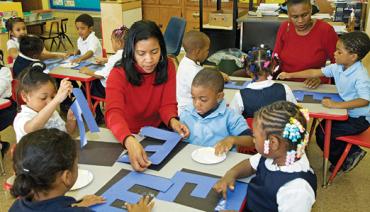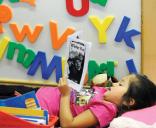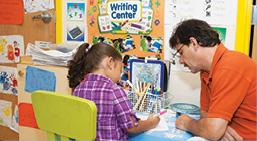The early years are times of wonder for children. Curious about everything, they seek to explore and understand their world. During these early years, they attempt to interpret their world and make meaning through pretend play, drawing, and conversations with those closest to them. Although these first steps toward literacy may not look much like what we consider literacy to be, children are actively trying to use and make sense of reading and writing long before they have mastered the technical skills associated with print.
For young children, reading and writing is literally a mixed medium, chock full of different symbolic activities like singing, dancing, talking, and playing, and this has important ramifications for what literacy instruction should look like. If we take a narrow, somewhat limited view of reading, then we might say that it’s all about learning the letter names, letter sounds, and conventions of print. But if we begin to think from a child’s point of view, literacy and the ways in which we should teach it include so much more.
What’s important to recognize is that children are active constructors of meaning.1 Adults play a critical role in their lives by engaging their interests, creating challenging but achievable goals, and supporting their efforts to understand through their many questions and unique interpretations. The adults in children’s lives are their first literacy teachers, and educator collaboration with families and communities is critical to children’s well-being and their school success.
How Literacy Learning Begins
Literacy learning begins early in young children’s lives. As children gain facility with different symbol systems, they begin to develop the insight that specific kinds of marks—print—represent meanings. At first, they’ll use physical and visual cues, like logos in environmental print, to determine what something says. Many parents will delight in seeing their children recognize common labels in the grocery store, and then see how their children are beginning to make the assumption that print is permanent. Soon after, they will begin to understand that within these signs, there are letters and sounds. Although it may seem as though some children acquire these understandings magically or on their own, studies suggest that they are the beneficiaries of considerable, though playful and informal, adult guidance and instruction.2
Nevertheless, there is considerable diversity in children’s oral and written language development. Just like walking and crawling, the timetable for when children begin to talk and write varies dramatically. Some children will begin talking as early as 18 months; others, not until much later. Furthermore, children encounter many different resources and types and degrees of support for early reading and writing. Some children may have ready access to a wide range of books, while others may not. Some children will observe their parents writing and reading frequently, others only occasionally. And some children will receive direct instruction, while others much more casual, informal assistance.3
What this means is that children come to school with many different experiences and skills. Consequently, no one teaching method or approach is likely to be the most effective for all children. Rather, good teachers bring into play a variety of teaching strategies that can encompass the great diversity of children in our schools. Excellent instruction builds on what children already know and can do, and provides knowledge, skills, and dispositions for lifelong learning.
Strategies for Building Literacy Skills
Children will need to learn the technical skills of reading and writing. Letter knowledge, phonological awareness, and an understanding of speech/sound correspondences are essential for children to learn how to become readers and writers. However, children must also learn how to use these tools to better their thinking and reasoning. Developing oral language comprehension and engaging children in meaningful oral discourse is crucial because it gives meaning to what they are learning.
Shared Reading Experience
One of the most powerful strategies for building these skills in early childhood is the shared reading experience.4 In listening to stories, children begin to pay attention to print, which reinforces print conventions and concepts in the context of a meaningful experience. (For more on the importance of read-alouds, see "Reading to Learn from the Start.") But they also hear words outside of their day-to-day discourse, which can help them build vocabulary. The conversational duets that occur around shared book reading can affect children’s vocabulary growth and comprehension of stories. Children may talk about the pictures, retell the story, discuss their favorite actions, and request multiple rereadings, which will enhance their understanding. These exchanges help children to bridge what is in the story and their own lives. Providing children with a rich array of information books is likely to enhance their conversations as they try to learn and understand more about their world.
Discovery Areas
Young children also need the opportunity to make choices and to practice what they have learned about print with their peers and on their own. Creating discovery areas for children to explore their understandings, with attractive stories and information books, helps children to integrate play and print. In these engaging discovery areas, children will often pretend to be scientists, veterinarians, or environmentalists, using books to support their understandings. Play is a crucial feature in developing early literacy for young children, because it helps them to interpret their experiences. Play allows young children to assume the roles and activities of more accomplished peers and adults.
Drawing and Writing on Paper
Classrooms that provide children with regular opportunities to express themselves on paper, without feeling too constrained by correct spelling and proper handwriting, also help children understand that writing has real purpose. Teachers can organize situations that both demonstrate the writing process and get children actively involved in it.
Some teachers help children write down their ideas, keeping in mind the balance between children doing it themselves and asking for help. In the beginning, these products likely emphasize pictures, with few attempts at writing letters or words. With encouragement, children begin to label their pictures, tell stories, and attempt to write stories about the pictures they have drawn.
Such novice writing activities send the important message that writing is not just handwriting practice—children are using their own words to compose a message to communicate with others.
Reading and Comprehension
For children to become skilled readers, they will also need to develop a rich conceptual knowledge base and verbal reasoning abilities to understand messages conveyed through print. Successful reading ultimately consists of having a toolkit of procedural skills (e.g., alphabet skills), accompanied by a massive and slowly built-up store of conscious content knowledge.5 It is the higher-order thinking skills, knowledge, and dispositional capabilities that enable young children to come to understand what they are reading.
Children’s earliest experiences become organized or structured into schemas, building blocks of cognition. Schemas provide children with the conceptual apparatus for making sense of the world around them by classifying incoming bits of information into similar groupings. Well-read-to children internalize a form of story grammar, a set of expectations of how stories are told, which enhances their understanding. Knowledge becomes easier to access, producing more knowledge networks. And those with a rich knowledge base find it easier to learn and remember.
Quality indicators of a rich content base for instruction in early childhood programs include a content-rich curriculum in which children have opportunities for sustained and in-depth learning, including play; different levels of guidance to meet the needs of individual children; a masterful orchestration of activity that supports content learning and social-emotional development; and time, materials, and resources that actively build verbal reasoning skills and conceptual knowledge.
In brief, the picture that emerges from research in these first years of children’s reading and writing is one that emphasizes wide exposure to print and to developing concepts about it and its forms and functions.6 Classrooms filled with print, language and literacy play, storybook reading, and writing allow children to experience the joy and power associated with reading and writing while mastering basic concepts about print that research has shown are strong predictors of achievement.
Policy Recommendations for Early Literacy Achievement
Today, the field of early childhood remains a fractured set of programs with little consistency, operating in widely differing contexts with varying levels of funding and resources. Some programs are in public schools, while others are part of community-based organizations or provided in family child care homes.
Policymakers need to integrate funding streams to ensure that the workforce in early childhood is adequately compensated, and that children receive highly qualified teachers and the appropriate resources in all contexts. Specifically, to enhance early literacy, we need:
Professional Development for Early Childhood Educators
A comprehensive, consistent system of early childhood professional preparation and ongoing professional development is badly needed in every state to ensure that staff in early childhood programs and teachers in primary schools receive content-rich, college-level education that informs them about developmental patterns in early literacy learning and about research-based strategies to intensify the content that children are learning during the early childhood years. Ongoing professional development is essential for teachers to stay current with the ever-expanding research base and to continually improve their teaching skills and the learning outcomes for children.
Smaller Class Sizes
Sufficient resources are needed in early childhood to ensure adequate ratios of qualified teachers to children and to ensure small groups for individualizing instruction. For 4- and 5-year-olds, adult-child ratios should be no more than 1 adult for 8 to 10 children, with a maximum group size of 20. Having small classes increases the likelihood that teachers will be able to accommodate children’s diverse abilities, interests, strengths, and needs.
Reading Materials, Especially Books and Digital Media
Sufficient resources are needed to ensure classrooms, schools, and public libraries have a wide range of high-quality children’s books, computer software, and multimedia resources at various levels of difficulty and reflecting various cultural and family backgrounds. Studies have found that a minimum of five books per child is necessary to provide even the most basic print-rich environment. Digital media, such as e-books, should also be available to provide alternative, engaging, and enriching literacy experiences.
Resources for Individualized Instruction
Finally, we need policies that promote children’s continuous learning progress. When individual children do not make expected progress in literacy development, resources should be available to provide more individualized instruction, focused time, tutoring by trained and qualified tutors, or other individualized intervention strategies. These instructional strategies are used to accelerate children’s learning instead of either grade retention or social promotion, neither of which has been proven effective in improving children’s achievement.
We cannot underestimate the importance of the early childhood years in children’s overall development and literacy learning. What we do in these early years will make a difference in their reading patterns, interests, and lifelong desire to learn.
Susan B. Neuman is a professor of childhood education and literacy development in the Department of Teaching and Learning at the Steinhardt School of Culture, Education, and Human Development at New York University. Previously, she was a professor of educational studies at the University of Michigan, where she directed the Ready to Learn Project. She has authored numerous books on early childhood, including Giving Our Children a Fighting Chance: Poverty, Literacy, and the Development of Information Capital. This article was excerpted with permission from “What Effective Pre-K Literacy Instruction Looks Like,” a brief published by the International Literacy Association in 2018.
Endnotes
1. Richard C. Anderson and P. David Pearson, “A Schema-Theoretic View of Basic Processes in Reading,” in Handbook of Reading Research, ed. P. David Pearson (New York: Longman, 1984), 255–291.
2. Barbara Foorman et al., Foundational Skills to Support Reading for Understanding in Kindergarten through 3rd Grade (Washington, DC: U.S. Department of Education, 2016).
3. Monique Sénéchal et al., “Differential Effects of Home Literacy Experiences on the Development of Oral and Written Language,” Reading Research Quarterly 33 (1998): 96–116.
4. Suzanne E. Mol, Adriana G. Bus, and Maria T. de Jong, “Interactive Book Reading in Early Education: A Tool to Stimulate Print Knowledge as Well as Oral Language,” Review of Educational Research 79 (2009): 979–1007.
5. E. D. Hirsch Jr., “Reading Comprehension Requires Knowledge—of Words and the World: Scientific Insights into the Fourth-Grade Slump and the Nation’s Stagnant Reading Comprehension Scores,” American Educator 27, no. 1 (Spring 2003): 10–22, 28–29, 48; and Susan B. Neuman and Tanya Kaefer, “Developing Low-Income Children’s Vocabulary and Content Knowledge through a Shared Book Reading Program,” Contemporary Educational Psychology 52 (2018): 15–24.
6. Suzanne E. Mol and Adriana G. Bus, “To Read or Not to Read: A Meta-Analysis of Print Exposure from Infancy to Early Adulthood,” Psychological Bulletin 137 (2011): 267–296; and Susan B. Neuman and Kathleen Roskos, “Literacy Knowledge in Practice: Contexts of Participation for Young Writers and Readers,” Reading Research Quarterly 32 (1997): 10–32.



